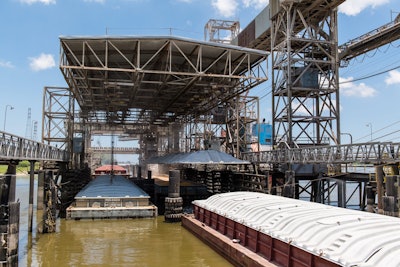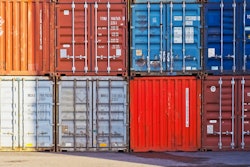
This is the second in a U.S. Grains Council (USGC) series exploring modes of transportation within the U.S. grain supply chain that provide a reliable supply of U.S. coarse grains, co-products and ethanol to the world’s market.
Flowing from farms in the Corn Belt down to the Mississippi River and into ports on the Gulf of Mexico, more than 12,000 miles of marine highways are a crucial part of the U.S. grain supply chain -- one that has continued to operate in spite of the COVID-19 pandemic.
“U.S. geography happens to be extremely suitable for the ag trade and ag export business,” says Thomas Russell, president of The Russell Marine Group, who has compiled a monthly river condition report for the last 10 years. “The network of inland waterways and natural ports throughout coastal locations make water transport the most economical way to move large amounts of bulk grain.”
Easy Access From Farm to Port
Because inland waterways run through the U.S. Corn Belt, they provide easy access for grain to move through the system to ports of export and delivery to importing countries. The corn from Midwestern farmers can arrive in an import destination in Mexico just weeks after they deliver it to either a conveniently-located country elevator or a well-positioned river terminal. Inland country elevators also move grain by truck or ship to these terminals.
Whether delivered directly by a farmer or by another elevator, once the grain arrives at the river, it is loaded onto barges and down the river it starts to flow.
“Dozens of elevators are located up and down the river system,” Russell says. “These elevators act as collection points where the grain is usually loaded into barges and transported to the Louisiana Gulf, where it is transferred into ocean vessels and exported.”
Ports on the Gulf of Mexico constitute more than 1.3 billion bushels (33 million metric tons) of demand for U.S. corn. Most of this grain moves downward through the inland waterway system and is destined for the export market. A combination of access, infrastructure and economics make logistics extremely efficient.
“Simply put, inland waterways transportation is the most cost-competitive way to move our nation’s bulk commodities,” says Deb Calhoun, interim president/CEO of Waterways Council, Inc. “The inland waterways move cargo in the safest, most energy-efficient, environmentally friendly way.”
From the barges on the river to the vessels at port, corn and co-products will move to destinations all over the world, including Mexico, Japan, South Korea, Spain and many others. This ocean transit is also highly efficient.
Ocean vessels come in numerous shapes, sizes, and serve a multitude of purposes, some of which are highly specialized,” Russell says. “Shipping via water is reliable, most economical on a cost-per-ton mile basis, and fuel-efficient, producing a low carbon footprint.”
Shared Commitment Keeps Rivers And Ports Open During COVID-19
Despite the enormity of the U.S. inland waterways system, both Russell and Calhoun report the river and port systems continue to operate unhindered by coronavirus.
“Currently, all locks and dams are operating normally,” Calhoun says. “Companies, grain elevators and terminals and the U.S. Army Corps of Engineers are continuing to conduct business while closely monitoring their operations and workforce to keep employees safe and healthy.”
Russell reports that at the Port of New Orleans, everyone involved -- loading terminals, grain houses, the U.S. Department of Agriculture’s Federal Grain Inspection Service (USDA’s FGIS), ship pilots, tugboat operators and all the vendors who participate in port activities -- agreed to commit to keeping the port open in the interest of global economic and food security. The groups also worked together on building contingency plans, if needed, to address labor shortages or other needs.
“Everyone in the port got together early and committed to keeping the port open because we understood the importance of doing so,” Russell says. “The port is vital to the U.S. economy and vital to the world food supply.”
With that shared strategy in place, new policies and procedures are in place to protect workers from all nations. For example, the river and port pilots that safely navigate ships into and out of the port itself set up safety protocols for every ship to comply with, which were conveyed to ship owners and each individual ship captain. Those protocols included minimal personnel on a ship’s bridge when the pilot went on board, disinfection procedures and exchanging forms through a door instead of sitting together to complete necessary paperwork.
“There has been no disruption,” Russell said. “The pilots have been completely satisfied with what the ship owners and captains have been doing. Everyone's trying to follow as best they can safety protocols and distancing. It's worked, we have not really had any major problems.”
Russell reported there have been isolated incidents in which a crew member needed to be quarantined, or a terminal pulled a whole crew for isolation due to one member showing symptoms. But with a plan actively in place, at no time did these actions cause any interruptions to the grain supply chain.
To read the full report at grains.org, click here.
About The U.S. Grains Council
The U.S. Grains Council develops export markets for U.S. barley, corn, sorghum and related products including distiller’s dried grains with solubles (DDGS) and ethanol. With full-time presence in 28 locations, the Council operates programs in more than 50 countries and the European Union. The Council believes exports are vital to global economic development and to U.S. agriculture’s profitability. Detailed information about the Council and its programs is online at grains.org.


















